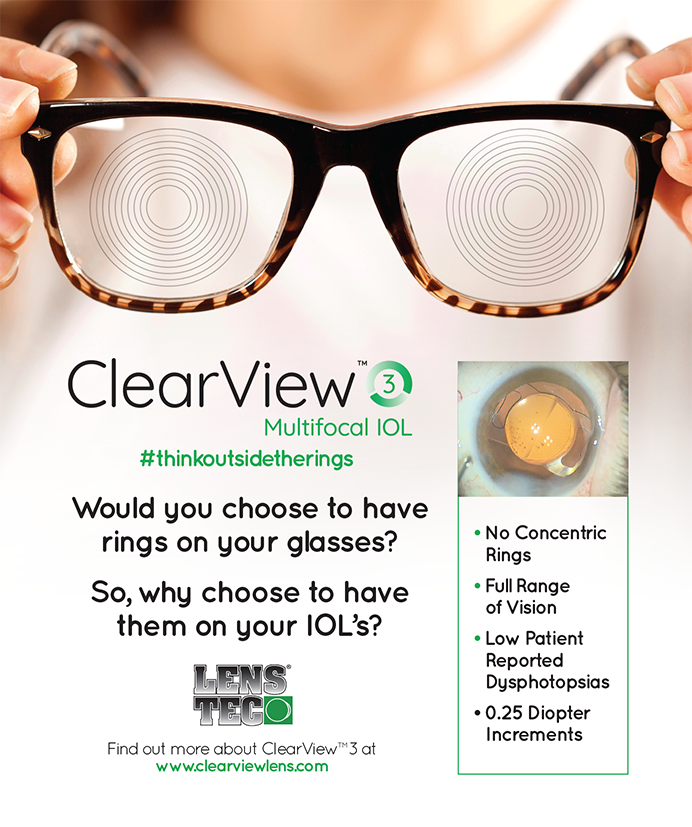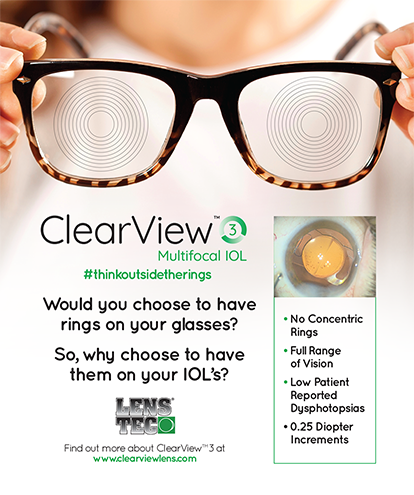
I will begin by showing my age. As a resident, I performed well over 200 intracapsular cataract extractions. I made a 180º limbal incision, the assistant held up the cornea, and I placed a cryo instrument on the lens, moved the instrument around to break the zonules, and (it was to be hoped) delivered the lens without beating up the cornea or the eye too much. The IOLs of the day had to be placed in the anterior chamber and were, by contemporary standards, rudimentary and crude in every way. The vast majority of patients instead received aphakic spectacles that grossly distorted postoperative vision, an approach that was widely considered sound and prudent care. It is difficult today to imagine the extreme opposition to IOLs offered by highly respected ophthalmologists, efforts that included an attempt to have the devices outlawed by Congress.
The technique of extracapsular cataract extraction was coming into flower and represented a major change in what surgeons could offer to patients. It became possible to implant an IOL in an intact posterior chamber. I remember one grand rounds exchange during my residency in which the visiting professor told my chief that various luminaries considered the anterior chamber to be a far superior place for lenses. My chief replied, “If you want to cite authorities, God put the lens in the posterior chamber.” That seemed to end the conversation.
AT A GLANCE
• Physicians never go wrong in focusing on patients’ needs and outcomes.
• The evolution of cataract surgery from extracapsular to intracapsular extraction to phacoemulsification and from anterior chamber implants to foldable posterior chamber IOLs were milestones that dramatically improved patients’ lives.
• Without heavy marketing and the magic word laser, laser cataract surgery would be a nonstarter.
It had always seemed pointless to make a small incision that then had to be expanded to accommodate the IOL. Phacoemulsification came into its own with much better instrumentation and foldable lens implants. With the development of reliable ultrasound technology, all of a sudden, ophthalmologists could reduce or even eliminate significant refractive errors. It is difficult to exaggerate what all of this meant to the profession and, more importantly, to the public.
Physicians never go wrong in focusing on patients’ needs and outcomes, which brings me to the present day. During my career, the seismic changes in cataract surgery I have described dramatically improved the results delivered to patients. I do not believe the same can be said of laser cataract surgery as it currently exists.
A LACK OF SIGNIFICANCE
Even if every single claim made about the superiority of the laser procedure over conventional cataract surgery were true, the former would still be a modest improvement at best. A recent analysis of the safety and efficacy of manual and laser cataract surgery involving 14,567 eyes found no significant difference in visual or refractive outcomes between the two groups.1
REVERSE ENGINEERING
It seems to me that there have been many instances of technology in search of an indication. Steve Jobs took the consumer experience that he wanted people to have, and then he and his team at Apple reasoned or engineered backward from that. He did not look at what his engineers could do at that particular moment and then focus on how to make people want whatever it was, whereas I believe this is the approach now used with laser cataract surgery.
Early on, ophthalmologists were informed that the femtosecond laser could make a perfectly round capsulotomy. They were also told that this opening was stronger and that it would make the IOL center better. No real explanation or evidence was provided for either assertion, both of which were tirelessly repeated nonetheless. Begging the question is a form of logical fallacy in which a statement or claim is assumed to be true without evidence other than the statement or claim itself. I have yet to attend a laser meeting where the main emphasis was not on marketing. To this old codger, who should perhaps retire and get out of everyone’s way, it seems like, since about 1960, all I see in this field is the replacement of things that work with things that sound good.
I will be told that patients want to have the laser, that they see an advantage in the technology, and that they will be more satisfied with it. I believe that they are happier with how the word laser sounds than with anything that the technology actually delivers. I doubt that it would have been adopted—certainly at its current cost—if laser were not included in the name. I would further submit that this word can demean the profession: they do it with a laser, so how hard can it be? If laser cataract surgery had to stand on its merits with its current additional costs and not on a magical word and marketing, I believe the technology would be a nonstarter.
WHAT IF?
If laser cataract surgery had been developed before conventional phacoemulsification, I could easily tell any surgeon what a huge improvement the latter was. There is no need to buy an insanely expensive machine. There are no click fees. Phacoemulsification has faster patient throughput and far greater simplicity, and there is one fewer machine to malfunction or perform unpredictably. I can use the current technology for virtually any case.
There is no such thing as the foreseeable future. Big changes in laser or other technology for cataract surgery could, of course, produce vastly superior outcomes for patients. I am speaking only of today.
1. Popovic M, Campos-Möller X, Schlenker MB, Ahmed II. Efficacy and safety of femtosecond laser-assisted cataract surgery compared with manual cataract surgery: a meta-analysis of 14,567 eyes. Ophthalmology. 2016;123(10):2113-2126.




